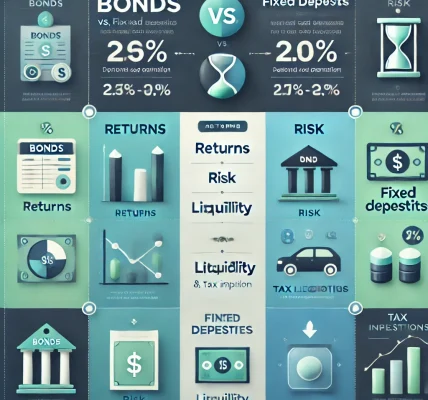Introduction: In the world of investing, understanding the various types of bonds is crucial to building a diversified and balanced portfolio. Among these, sovereign bonds stand out as a popular investment choice for many investors. But what exactly are sovereign bonds, and why should you consider them? In this guide, we’ll delve into the details of sovereign bonds, how they work, their risks, and why they are essential in the world of finance.
What Are Sovereign Bonds? Sovereign bonds are debt securities issued by a country’s government to raise capital for public spending, infrastructure projects, or managing national debt. Essentially, when you invest in a sovereign bond, you are lending money to the government. In return, the government promises to pay back the principal (the original amount invested) on a specified maturity date, along with periodic interest payments (coupon payments) over the life of the bond.
Key Characteristics of Sovereign Bonds:
- Issuer: Sovereign bonds are issued by national governments.
- Risk Level: Considered relatively low-risk, as they are backed by the government’s creditworthiness.
- Interest Payments: Investors receive regular coupon payments at a fixed or floating interest rate.
- Maturity Period: The maturity period can range from a few months to several decades, depending on the bond’s terms.
Types of Sovereign Bonds:
- Treasury Bonds (T-Bonds): These are long-term bonds issued by the U.S. government, typically with maturities ranging from 10 to 30 years.
- Government Bonds (Gilts): Issued by the UK government, these bonds are similar to U.S. Treasury Bonds and are considered one of the safest investments.
- Municipal Bonds: Although primarily issued by local governments, municipal bonds are still part of the sovereign bond category, offering interest income that is often tax-exempt.
How Do Sovereign Bonds Work? When a government needs funds, it issues sovereign bonds to investors in the open market. These bonds are sold at a fixed interest rate, and the government promises to repay the face value at maturity. Let’s break down the process:
- Issuance: The government issues sovereign bonds via auctions, offering a fixed interest rate (or coupon rate) to attract buyers.
- Interest Payments: Bondholders receive interest payments periodically (usually every 6 months or annually).
- Maturity: At the end of the bond’s maturity period, the government repays the principal amount to the bondholders.
Why Should You Invest in Sovereign Bonds? Sovereign bonds offer several benefits that make them a vital part of any balanced investment portfolio. Here are a few key reasons to consider them:
- Safety and Stability: Since these bonds are issued by national governments, they are generally considered low-risk investments. Bonds from stable economies, such as the U.S., Japan, and Germany, carry minimal default risk.
- Predictable Income: The fixed interest payments on sovereign bonds provide predictable income, making them attractive to conservative investors seeking stability.
- Diversification: Including sovereign bonds in your portfolio can help reduce overall risk by diversifying investments across asset classes. Bonds tend to perform well when stocks are volatile, offering a cushion during market downturns.
- Tax Benefits: In some cases, sovereign bonds offer tax advantages. For example, U.S. Treasury bonds are exempt from state and local taxes, making them a popular choice for investors.
- Global Investment Opportunities: Sovereign bonds are available in many countries, providing investors access to global markets. You can diversify your bond holdings by investing in bonds from different nations, further reducing risk.
Risks of Sovereign Bonds: While sovereign bonds are generally considered safe, they do carry some risks. Let’s look at a few:
- Inflation Risk: If inflation rises significantly, the fixed interest payments on sovereign bonds may lose purchasing power, making them less attractive.
- Interest Rate Risk: When interest rates rise, bond prices tend to fall. This can lead to capital losses if you need to sell your bond before maturity.
- Sovereign Default Risk: In extreme cases, a country may default on its debt, meaning it fails to repay the bondholders. While rare, this risk is higher in emerging markets or countries with weaker economies.
How to Invest in Sovereign Bonds? Investing in sovereign bonds can be done through several avenues:
- Direct Purchase: You can buy bonds directly from the government during auctions or through a brokerage account.
- Bond Funds or ETFs: Many investors prefer to invest in sovereign bond mutual funds or exchange-traded funds (ETFs) to gain exposure to a diversified range of bonds.
Conclusion: Sovereign bonds are an essential component of a well-rounded investment strategy, offering stability, predictable returns, and diversification. Whether you’re a conservative investor looking for safe, steady income or someone seeking to diversify your portfolio, sovereign bonds can be a great addition. However, it’s crucial to understand the risks involved, such as inflation and interest rate fluctuations. As with any investment, make sure to do thorough research and consult with a financial advisor to determine how sovereign bonds can fit into your overall investment goals.




